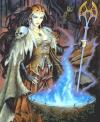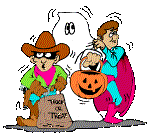      
|
|
English for Fun <<< Celebrations around the World <<< Halloween |
 Halloween or All Hallow's Eve is celebrated on the night of October 31 when people in the United States and other countries (mainly in the Western world) dress up in costumes, carve faces on pumpkins and light them. They hold Halloween parties, which include such activities as fortunetelling, storytelling about ghosts and witches, and bobbing for apples. American children wear scary costumes and go trick-or-treating. The modern Halloween is a very distant descendent of the ancient Celtic fire festival called "Samhain"1. The Celts, who lived 2,000 years ago in the area that is now Ireland, the United Kingdom, and northern France, celebrated their New Year on November 1. On the night of October 31, they celebrated Samhain, when it was believed that the ghosts of the dead returned to Earth to cause trouble and damage crops. The Celts were a pastoral people as opposed to an agricultural people. The end of summer was significant to them because it meant the time of year when the structure of their lives changed radically. The cattle and sheep were brought in from summer pastures and the people were gathered into the houses for the long winter nights of story-telling and handicrafts. Celtic tradition held that turning points, times when things change from one state to another, had magical properties. Samhain literally means "Summer's End" and was observed with both harvest and religious rites. Legends tell us that on the night of October 31st, the Druids, the pagan priest of the Celts, built a huge bonfire of oak branches, which they considered sacred. They burned animals, fruits, vegetables and possibly even human beings as sacrifices. The Ancient Druids were well-educated in astrology and magic. They celebrated the Earth, the Moon, the Sun, the stars and all the plants, minerals and creatures of the Earth as having powerful magical vibrations.  The Celts believed that on the night before the New Year the boundary between the worlds of the living and the dead became blurred. The story goes that, the spirits of anyone who had died that year would come back looking for living bodies to possess. So, during the celebration, the Celts dressed up in freaky, scary costumes, typically consisting of animal heads and skins, hoping that the spirits would be frightened and not bother them. When the celebration was over, they re-lit their hearth fires, which they had extinguished earlier that evening, from the sacred bonfire. The Celts also thought that the presence of the spirits made it easier for the Druids to make predictions about the future. For a people entirely dependent on the natural world, these prophecies were an important source of comfort and direction during the long, dark winter. During the first century the Romans invaded Britain and two Roman festivals were combined with the Celtic Samhain festival. The first Roman festival was Feralia, a day in late October when the Romans traditionally commemorated the passing of the dead. The second was a day to honor Pomona, the Roman goddess of fruit and gardens. The symbol of Pomona is the apple and the incorporation of this celebration into Samhain probably explains the tradition of "bobbing" for apples practiced today on Halloween. The next influence came with the spread of the new Christian religion throughout Europe and Britain. In the year 835 AD the Roman Catholic Church set November 1 as All Saints' Day, a time to honor saints and martyrs. The celebration was also called All-hallows or All-hallowmas (from Middle English Alholowmesse meaning All Saints' Day) and the night before it, the night of Samhain, began to be called All-hallows Eve and, eventually, Halloween. Even later, in A.D. 1000, the church would make November 2 All Souls' Day, a day to honor the dead. It was celebrated with big bonfires, parades, and people dressing up as saints, angels and devils.
Perhaps the most prominent symbol of the Halloween is the Jack-o'- Lantern (Jack of the Lantern). The Jack-o'-Lantern, a carved vegetable lit by a candle inside, probably comes from Irish folklore about a man named Jack who tricked the devil into climbing a tree. Once the devil was in the tree, Jack carved a cross on the trunk, preventing the devil from coming down. The devil then made a deal with Jack to not allow Jack into hell after Jack died if only Jack would remove the cross from the tree.  According to the folk tale, after Jack died, he was denied entrance to Heaven because of his evil ways, but he was also denied access to Hell because he had tricked the devil. He was forced to wander around the earth with a single candle to light his way. The candle was placed in a turnip to keep it burning longer. When the Irish came to America they adopted the pumpkin instead of the turnip. Along with these traditions, they brought the idea that the black cat was considered by some to be reincarnated spirits who had prophetic abilities. The custom of trick-or-treating is thought to have originated not with the Irish Celts, but with a ninth-century European custom called souling. On November 2, All Souls Day, early Christians would walk from village to village begging for "soul cakes," made out of square pieces of bread with currants. The more soul cakes the beggars would receive, the more prayers they would promise to say on behalf of the dead relatives of the donors. At the time, it was believed that the dead remained in limbo for a time after death, and that prayer, even by strangers, could expedite a soul's passage to heaven. Immigrants from Ireland, Scotland and England, brought secular Halloween customs to the U.S. but the festival did not become popular until the latter part of the 19th century. In 1840 when the potato crop in Ireland failed, many of the Irish people immigrated to America, bringing with them their folk practices, which are the remnants of the Celtic festival observances.
By the 1920s and 1930s, Halloween had become a secular, but community-centered holiday, with parades and town-wide parties as the featured entertainment. Despite the best efforts of many schools and communities, vandalism began to plague Halloween celebrations in many communities during this time. By the 1950s, town leaders had successfully limited vandalism and Halloween had evolved into a holiday directed mainly at the young. Due to the high numbers of young children during the fifties baby boom, parties moved from town civic centers into the classroom or home, where they could be more easily accommodated. Between 1920 and 1950, the centuries-old practice of trick-or-treating was also revived. Trick-or-treating was a relatively inexpensive way for an entire community to share the Halloween celebration. In theory, families could also prevent tricks being played on them by providing the neighborhood children with small treats. A new American tradition was born, and it has continued to grow. Today, school dances and neighborhood parties called "block parties" are popular among young and old alike. Adults dress up like historical or political figures and go to masquerade parties. Stores and businesses give parties with games and treats for the children. Every year, Americans spend an estimated $6.9 billion on Halloween costumes, candy, pumpkins and decorations, which makes it the second-largest commercial holiday in the country after Christmas.
Next page: Halloween Symbols |
Site Map | Advertising | Privacy Policy | About This Project |
© Copyright 2002 - 2021. Author and design M. Boyanova. |
 Halloween
Halloween
